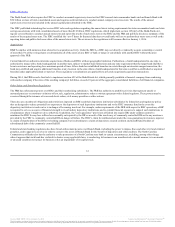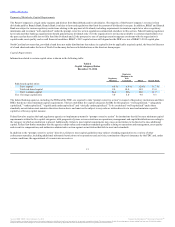BB&T 2014 Annual Report Download - page 23
Download and view the complete annual report
Please find page 23 of the 2014 BB&T annual report below. You can navigate through the pages in the report by either clicking on the pages listed below, or by using the keyword search tool below to find specific information within the annual report.
Table of Contents
BB&T may be subject to more stringent capital requirements, which could diminish its ability to pay dividends or require BB&T to reduce its operations.
The Dodd-Frank Act requires federal banking agencies to establish more stringent risk-based capital requirements and leverage limits applicable to banks and
BHCs. During 2013, the FRB approved final rules that established a new comprehensive capital framework for U.S. banking organizations and established a
more conservative definition of capital. Once adopted and fully phased in, banking organizations such as BB&T would be required to meet enhanced
minimum capital and leverage ratios. These requirements, and any other new regulations, including those that have been proposed but not yet implemented
as a result of the requirements established by the BCBS, could adversely affect BB&T’s ability to pay dividends, or could require BB&T to limit certain
business activities or to raise capital, which may adversely affect its results of operations or financial condition. In addition, the costs associated with
complying with more stringent capital requirements, such as the requirement to formulate and submit capital plans based on pre-defined stress scenarios on
an annual basis, could have a material adverse effect on BB&T. See “Regulatory Considerations” for additional information regarding the capital
requirements under the Dodd-Frank Act and Basel III.
Differences in interpretation of tax laws and regulations and any potential resulting litigation may adversely impact BB&T’s financial statements.
Local, state or federal tax authorities may interpret tax laws and regulations differently than BB&T and challenge tax positions that BB&T has taken on its
tax returns. This may result in differences in the treatment of revenues, deductions, credits and/or differences in the timing of these items. The differences in
treatment may result in payment of additional taxes, interest or penalties that could have a material adverse effect on BB&T’s results. For example, as
discussed in Note 13 “Income Taxes” in the “Notes to Consolidated Financial Statements,” in February 2010, BB&T received an IRS statutory notice of
deficiency for tax years 2002-2007 asserting a liability for taxes, penalties and interest of approximately $892 million. Related developments resulted in a
$516 million charge in 2013. Potential developments in BB&T’s litigation or in similar cases could adversely affect BB&T’s financial position or results of
operations.
Credit Risk
Changes in national, regional and local economic conditions and deterioration in the geographic and financial markets in which BB&T operates could
lead to higher loan charge-offs and reduce BB&T’s net income and growth.
BB&T’s business is subject to periodic fluctuations based on national, regional and local economic conditions. These fluctuations are not predictable,
cannot be controlled, and may have a material adverse impact on BB&T’s operations and financial condition even if other favorable events occur. BB&T’s
banking operations are locally oriented and community-based. Accordingly, BB&T expects to continue to be dependent upon local business conditions as
well as conditions in the local residential and CRE markets it serves. For example, an increase in unemployment, a decrease in real estate values or increases
in interest rates, as well as other factors, could weaken the economies of the communities BB&T serves. Weakness in BB&T’s market area could depress its
earnings and consequently its financial condition because:
·customers may not want or need BB&T’s products or services;
·borrowers may not be able or willing to repay their loans;
·the value of the collateral securing loans to borrowers may decline; and
·the quality of BB&T’s loan portfolio may decline.
Any of the latter three scenarios could require BB&T to charge off a higher percentage of loans and/or increase provisions for credit losses, which would
reduce BB&T’s net income. Credit deterioration, combined with flat to declining real estate values, would result in increased loan charge-offs and higher
provisions for credit losses, which may negatively impact BB&T’s net income.
A systemic lack of available credit, a lack of confidence in the financial sector, volatility in the financial markets and/or reduced business activity could
materially adversely affect BB&T’s business, financial condition and results of operations.
22
Source: BB&T CORP, 10-K, February 25, 2015 Powered by Morningstar® Document Research℠
The information contained herein may not be copied, adapted or distributed and is not warranted to be accurate, complete or timely. The user assumes all risks for any damages or losses arising from any use of this information,
except to the extent such damages or losses cannot be limited or excluded by applicable law. Past financial performance is no guarantee of future results.
























